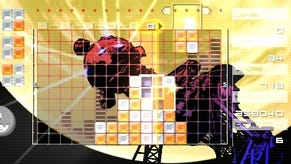Lumines
Falling for you.
Some game reviews are very difficult to write. This is one of them.
"Aha," you may be thinking. "You refer to the difficulty of reviewing a game on a brand new console without unwittingly also reviewing the console itself, and unfairly judging the game on the triumphs and failings of the hardware rather than on its own merits." You may even be nodding sagely and putting on your best sympathetic face as you think it.
That's not what I'm talking about, though. Certainly it can sometimes be difficult to get past the question of the hardware when talking about games on new platforms - early Xbox games were often unfairly lambasted for the discomfort caused by Microsoft's disastrous original controller, while GBA titles suffered from being on a console whose screen could only be seen with the assistance of a Sam Fisher's night vision - but in the case of Lumines, the difficulty arises for an entirely different and altogether more positive reason.
It's simply this. Just before before writing the review of a game, I tend to return to for a few minutes to check some final things out and make sure that the experience is fresh in my mind. In the case of Lumines, that has turned out to be a mistake - one which has cost me my lunchtime, in fact. I like my food. It transpires that I may well like dropping multicoloured blocks through a vivid soundscape even better.
Bloc Party
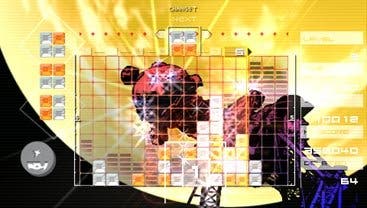
The concept behind Lumines is simple. You're given a huge grid as a play area (arranged in widescreen across the face of the PSP, unlike the tall narrow play areas which are the staples of one or two other puzzle games) and a selection of 2x2 blocks, made up of two colours arranged in a variety of patterns. Your objective is to create 2x2 blocks of the same colour in the play area - a line sweeps across at intervals which clears out any 2x2 blocks that exist, which means that if you time things right you can build up multiple blocks to be removed by a single sweep of the line, resulting in a multiplier bonus for your score.
That, essentially, is it - the only other elements to consider in the basic gameplay are special blocks with gems embedded in them, which eliminate all other blocks in contact with them when they're destroyed as part of a 2x2 square. You don't get many points for doing that, but it's a bit of a lifesaver in some circumstances, since it can prevent you from hitting the top of the play area - once you do that, it's Game Over.
There are some other very important stuff about Lumines which I'll discuss in a moment, but it's worth pointing out that even if this was a download game for my mobile phone or an old Game Boy Pocket title, this basic gameplay would still be very good indeed. It's easy to look at it in light of countless titles like Puyo Puyo, Tetris or Dr Mario and dismiss it as just another falling blocks puzzle, but Lumines has a unique flavour all of its own and forms a hugely addictive challenge that has seen the disc firmly jammed into the back of my PlayStation Portable for the past fortnight.
Mizuguchi no Go

Initially you play the game like any other falling block puzzle - you opportunistically create squares, try and build up relatively complex patterns, curse at the game when you time things wrong and the clearing line only sweeps away half of the blocks you just created because you created them while it was halfway through. After a few hours, though, one of two things will happen - either you'll get it, in which case Lumines will become a hopeless addiction for you, or you won't, in which case it will become a beautifully designed but somewhat frustrating curiosity in your collection.
"Getting it" in Lumines is perhaps best compared to the game of Go - a slightly obscure comparison, but bear with me. When you play Go, one of the most tactical and freeform board games in the world, one of the most important ways to improve your game is to learn to recognise patterns on the board and apply solutions to those patterns. Lumines is the same; if the game clicks with you, it's because you start to recognise patterns in the blocks, and you learn how you can clear those patterns using specific types of block. Eventually, you find yourself setting up those patterns deliberately, building a macro-level strategy for clearing a pile onto a micro-level solution for making some blocks to be cleared in the next sweep.
Things speed up, of course, and you have to think faster and act faster. Unlike Tetris, though, I didn't find that the biggest problem was making placement mistakes with blocks - you get to move the block into position at the top of the screen for a few seconds before it even starts falling so it's rare to drop a block somewhere you didn't mean to. The problem is that you eventually hit puzzles that you can't solve fast enough, and you lose - which is the kind of flexible barrier that's mentally taxing, and manages to be both satisfying and frustrating at the same time.
Sound of Music
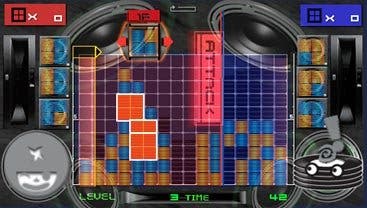
At this point you're probably questioning whether Lumines is really the kind of game that you want to be playing on your PlayStation Portable. The most powerful gaming handheld ever made, for Kutaragi's sake, and Bandai wants us to play a falling block puzzle on it? You have a point, but only to an extent. Lumines certainly doesn't tax the PSP hardware. There's not a polygon in sight, in fact. This isn't the game you're going to show your friends to justify the 500 quid you just spent on an import system - but that's not to say that it doesn't have a few tricks up its sleeve to take advantage of the hardware it's running on.
This is, after all, a Tetsuya Mizuguchi game. If the name isn't familiar, then perhaps the name "Rez" is. Mizuguchi is SEGA's former enfant terrible, the man who went from creating the likes of SEGA Rally to developing an obsession with audio that led to the likes of Space Channel 5 and cult classic Rez. Commercially he may be no Miyamoto, but Mizuguchi is Japan's Jeff Minter - he builds games which gamers talk about not just fondly, but with a touch of awe. He is also, by all reports, even cooler than Team Ninja's Tomonobu Itagaki - and Itagaki was born wearing sunglasses.
So it's only natural that Mizuguchi has done something a little bit special with the audio in Lumines which lifts it well away from the rest of the falling-block-puzzle genre. For one thing, the game boasts a soundtrack by Japanese electronica artists Mondo Grosso and Eri Nobuchika. These names may well mean nothing to you, but they're actually pretty damn good. Each track (referred to in the game as a "skin") comes with a different animated music video style background and differently-coloured blocks on the screen, and as you progress through the straightforward Challenge mode (play until you lose, basically) you'll unlock each new skin in turn, allowing you to use them in multiplayer or in the single-skin play mode.
The graphics aside - and don't get me wrong, they really do add a whole new element to Lumines - the audio is the real star of the show. Each skin not only has different graphics, but also new sound effects - so everything you do in the game actually builds up the music. Rotating and dropping the blocks gives the music its beats, clearing squares adds further elements, and getting combos or clearing special blocks builds the track to a crescendo. Rez fans will know what I'm talking about; those who haven't played Rez will just have to take my word for it that it sounds a lot better than you might imagine; and even if the description sounds gimmicky, the reality is that the fusion of music and gameplay feels very special indeed.
Block Riot
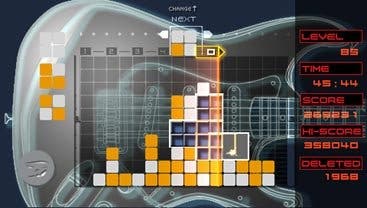
Of course, no puzzle game is complete without a set of additional modes to explore, and Lumines does not disappoint. In single-player mode, you can play time attack challenges (try and rack up the biggest score in a short space of time) or play in single skin mode once you find ones you really like. More interesting by far is a separate Puzzle mode, which presents you with a pattern of blocks and challenges you to recreate that pattern in the play area. Starting off simple, this can get fiendishly difficult when it is no longer possible to dump unwanted blocks on the side of the screen, and provides an excellent distraction from the Challenge mode.
In terms of multiplayer, the game offers both a Vs. CPU mode (which is another good distraction from Challenge mode, as the gameplay is quite different) and a two-player mode using wireless connectivity. The multiplayer mode is interesting, as both players actually play on the same play area - albeit with a partition down the middle which moves depending on how well you're doing. Clear a few blocks at once and the partition will encroach further into your opponent's territory, leaving him with less room to manoeuvre - and when the partition moves, the blocks underneath it do not, so you end up with a lump of the structure which he's constructing on your side of the play area.
It's a peculiar concept, but one which works very well and encourages players to get as many multiples as possible so as to squeeze their opponent into the smallest space possible. It's also important to stay on your toes, because a clever opponent can time their blocks to rob you of a structure which is just about to be cleared - just the kind of sneaky underhand tactic that can lead to people being bludgeoned to death with PSPs, in fact.
Cor Lummy
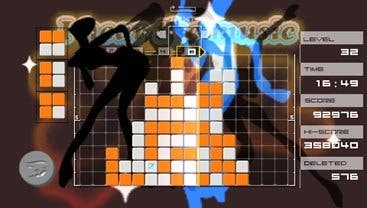
Lumines is a remarkably clever idea and one which is presented with a superb degree of polish. The music is great, the game is hugely addictive and very challenging, and the use of the music videos and changing skins almost makes it feel like this falling block puzzle is a decent use of your new handheld powerhouse. It certainly vies with Ridge Racers and Metal Gear Acid on my list of favourites from the PSP launch line-up, and you can even arguably exclude Metal Gear Acid from that list for its incomprehensibility to those who cannot read Japanese.
However, there are a few problems which it's important to mention - most notably the fact that the game is very buggy. It seems to be incapable of handling the UMD disc mechanism properly, and on several occasions it's reached the end of one "skin" and failed to load the next one, followed by hanging the console when it reached the end of the game and tried to load the menu. It also exhibits this behaviour whenever you suspend and resume a game, which is a real pain, and it's pretty amazing that this bug wasn't encountered by Bandai prior to release - we can only assume that the title was rushed through QA for launch, and hope that it's improved for its debut in the west, assuming of course we ever get to see a Western release.
The other problem, of course, is that I haven't had any lunch thanks to it. Tetsuya Mizuguchi owes me a sandwich - but I'll settle for a copy of the soundtrack, and a few pointers on how to get my score past the magical 100,000 mark. If puzzle games grab you at all, this is a must-have PSP title - which misses out on being a nine only as a result of the frustrating bugs in the game. Be prepared for some soul-searching when your super-powerful handheld ends up playing a 2D game for weeks on end, though.



